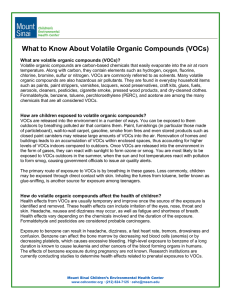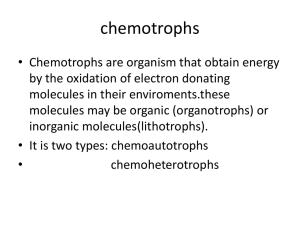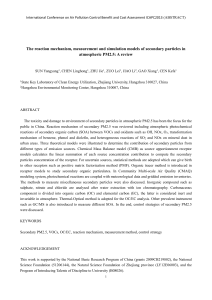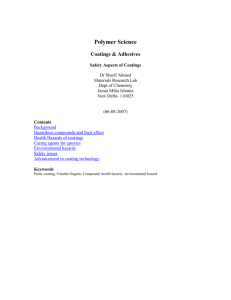Volitale Organic Com..
advertisement
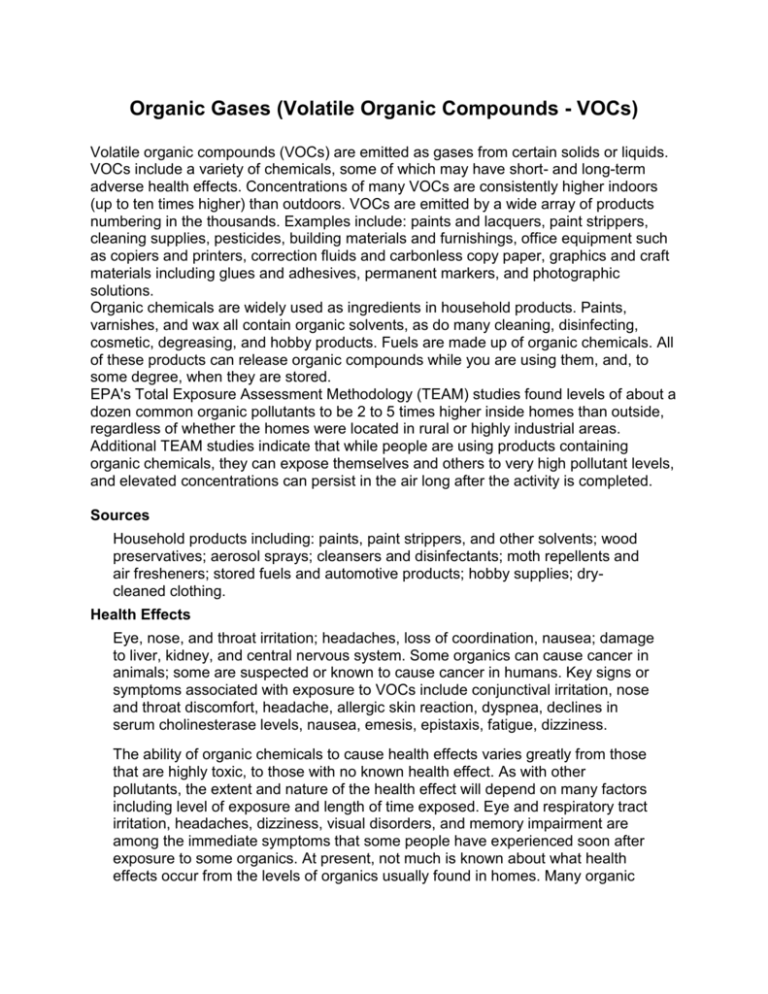
Organic Gases (Volatile Organic Compounds - VOCs) Volatile organic compounds (VOCs) are emitted as gases from certain solids or liquids. VOCs include a variety of chemicals, some of which may have short- and long-term adverse health effects. Concentrations of many VOCs are consistently higher indoors (up to ten times higher) than outdoors. VOCs are emitted by a wide array of products numbering in the thousands. Examples include: paints and lacquers, paint strippers, cleaning supplies, pesticides, building materials and furnishings, office equipment such as copiers and printers, correction fluids and carbonless copy paper, graphics and craft materials including glues and adhesives, permanent markers, and photographic solutions. Organic chemicals are widely used as ingredients in household products. Paints, varnishes, and wax all contain organic solvents, as do many cleaning, disinfecting, cosmetic, degreasing, and hobby products. Fuels are made up of organic chemicals. All of these products can release organic compounds while you are using them, and, to some degree, when they are stored. EPA's Total Exposure Assessment Methodology (TEAM) studies found levels of about a dozen common organic pollutants to be 2 to 5 times higher inside homes than outside, regardless of whether the homes were located in rural or highly industrial areas. Additional TEAM studies indicate that while people are using products containing organic chemicals, they can expose themselves and others to very high pollutant levels, and elevated concentrations can persist in the air long after the activity is completed. Sources Household products including: paints, paint strippers, and other solvents; wood preservatives; aerosol sprays; cleansers and disinfectants; moth repellents and air fresheners; stored fuels and automotive products; hobby supplies; drycleaned clothing. Health Effects Eye, nose, and throat irritation; headaches, loss of coordination, nausea; damage to liver, kidney, and central nervous system. Some organics can cause cancer in animals; some are suspected or known to cause cancer in humans. Key signs or symptoms associated with exposure to VOCs include conjunctival irritation, nose and throat discomfort, headache, allergic skin reaction, dyspnea, declines in serum cholinesterase levels, nausea, emesis, epistaxis, fatigue, dizziness. The ability of organic chemicals to cause health effects varies greatly from those that are highly toxic, to those with no known health effect. As with other pollutants, the extent and nature of the health effect will depend on many factors including level of exposure and length of time exposed. Eye and respiratory tract irritation, headaches, dizziness, visual disorders, and memory impairment are among the immediate symptoms that some people have experienced soon after exposure to some organics. At present, not much is known about what health effects occur from the levels of organics usually found in homes. Many organic compounds are known to cause cancer in animals; some are suspected of causing, or are known to cause, cancer in humans. Levels in Homes Studies have found that levels of several organics average 2 to 5 times higher indoors than outdoors. During and for several hours immediately after certain activities, such as paint stripping, levels may be 1,000 times background outdoor levels. Steps to Reduce Exposure Increase ventilation when using products that emit VOCs. Meet or exceed any label precautions. Do not store opened containers of unused paints and similar materials within the school. Formaldehyde, one of the best known VOCs, is one of the few indoor air pollutants that can be readily measured. Identify, and if possible, remove the source. If not possible to remove, reduce exposure by using a sealant on all exposed surfaces of paneling and other furnishings. Use integrated pest management techniques to reduce the need for pesticides. Use household products according to manufacturer's directions. Make sure you provide plenty of fresh air when using these products. Throw away unused or little-used containers safely; buy in quantities that you will use soon. Keep out of reach of children and pets. Never mix household care products unless directed on the label. Follow label instructions carefully. Potentially hazardous products often have warnings aimed at reducing exposure of the user. For example, if a label says to use the product in a well-ventilated area, go outdoors or in areas equipped with an exhaust fan to use it. Otherwise, open up windows to provide the maximum amount of outdoor air possible. Throw away partially full containers of old or unneeded chemicals safely. Because gases can leak even from closed containers, this single step could help lower concentrations of organic chemicals in your home. (Be sure that materials you decide to keep are stored not only in a wellventilated area but are also safely out of reach of children.) Do not simply toss these unwanted products in the garbage can. Find out if your local government or any organization in your community sponsors special days for the collection of toxic household wastes. If such days are available, use them to dispose of the unwanted containers safely. If no such collection days are available, think about organizing one. Buy limited quantities. If you use products only occasionally or seasonally, such as paints, paint strippers, and kerosene for space heaters or gasoline for lawn mowers, buy only as much as you will use right away. Keep exposure to emissions from products containing methylene chloride to a minimum. Consumer products that contain methylene chloride include paint strippers, adhesive removers, and aerosol spray paints. Methylene chloride is known to cause cancer in animals. Also, methylene chloride is converted to carbon monoxide in the body and can cause symptoms associated with exposure to carbon monoxide. Carefully read the labels containing health hazard information and cautions on the proper use of these products. Use products that contain methylene chloride outdoors when possible; use indoors only if the area is well ventilated. Keep exposure to benzene to a minimum. Benzene is a known human carcinogen. The main indoor sources of this chemical are environmental tobacco smoke, stored fuels and paint supplies, and automobile emissions in attached garages. Actions that will reduce benzene exposure include eliminating smoking within the home, providing for maximum ventilation during painting, and discarding paint supplies and special fuels that will not be used immediately. Keep exposure to perchloroethylene emissions from newly dry-cleaned materials to a minimum. Perchloroethylene is the chemical most widely used in dry cleaning. In laboratory studies, it has been shown to cause cancer in animals. Recent studies indicate that people breathe low levels of this chemical both in homes where dry-cleaned goods are stored and as they wear dry-cleaned clothing. Dry cleaners recapture the perchloroethylene during the drycleaning process so they can save money by re-using it, and they remove more of the chemical during the pressing and finishing processes. Some dry cleaners, however, do not remove as much perchloroethylene as possible all of the time. Taking steps to minimize your exposure to this chemical is prudent. If dry-cleaned goods have a strong chemical odor when you pick them up, do not accept them until they have been properly dried. If goods with a chemical odor are returned to you on subsequent visits, try a different dry cleaner. Standards or Guidelines No standards have been set for VOCs in non industrial settings. OSHA regulates formaldehyde, a specific VOC, as a carcinogen. OSHA has adopted a Permissible Exposure Level (PEL) of .75 ppm, and an action level of 0.5 ppm. HUD has established a level of .4 ppm for mobile homes. Based upon current information, it is advisable to mitigate formaldehyde that is present at levels higher than 0.1 ppm. Information obtained from US EPA

